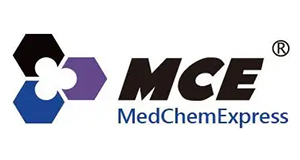Ciproxifan (hydrochloride), CAS 1049741-81-2
Ciproxifan (hydrochloride), CAS 1049741-81-2
SKU
MEXHY-14567A-0
Packaging Unit
Get quote
Manufacturer
MedChemExpress
Availability:
loading...
Price is loading...
Product Description: Ciproxifan (FUB 359) hydrochloride is a potent, selective, orally bioavailable and competitive antagonist of histamine H3-receptor, with an IC50 of 9.2 nM. Ciproxifan hydrochloride displays low apparent affinity at other receptor subtypes. Ciproxifan hydrochloride can be used for the research of aging disorders and Alzheimer's disease[1][3].
Formula: C16H19ClN2O2
References: [1]Ligneau X, et, al. Neurochemical and behavioral effects of ciproxifan, a potent histamine H3-receptor antagonist. J Pharmacol Exp Ther. 1998 Nov;287(2):658-66./[2]Motawaj M, Arrang JM. Ciproxifan, a histamine H₃-receptor antagonist / inverse agonist, modulates methamphetamine-induced sensitization in mice. Eur J Neurosci. 2011 Apr;33(7):1197-204. /[3]Mark E Bardgett, et al. Ciproxifan, an H3 receptor antagonist, alleviates hyperactivity and cognitive deficits in the APP Tg2576 mouse model of Alzheimer's disease. Neurobiol Learn Mem. 2011 Jan;95(1):64-72. /[4]Mark E Bardgett, et al. The H3 antagonist, ciproxifan, alleviates the memory impairment but enhances the motor effects of MK-801 (dizocilpine) in rats. Neuropharmacology. 2010 Nov;59(6):492-502./[5]Mark Day, et al. Differential effects of ciproxifan and nicotine on impulsivity and attention measures in the 5-choice serial reaction time test. Biochem Pharmacol. 2007 Apr 15;73(8):1123-34. /[6]Catherine Pillot, et al. Ciproxifan, a histamine H3-receptor antagonist/inverse agonist, modulates the effects of methamphetamine on neuropeptide mRNA expression in rat striatum. Eur J Neurosci. 2003 Jan;17(2):307-14.
CAS Number: 1049741-81-2
Molecular Weight: 306.79
Research Area: Endocrinology; Neurological Disease
Target: Histamine Receptor
Formula: C16H19ClN2O2
References: [1]Ligneau X, et, al. Neurochemical and behavioral effects of ciproxifan, a potent histamine H3-receptor antagonist. J Pharmacol Exp Ther. 1998 Nov;287(2):658-66./[2]Motawaj M, Arrang JM. Ciproxifan, a histamine H₃-receptor antagonist / inverse agonist, modulates methamphetamine-induced sensitization in mice. Eur J Neurosci. 2011 Apr;33(7):1197-204. /[3]Mark E Bardgett, et al. Ciproxifan, an H3 receptor antagonist, alleviates hyperactivity and cognitive deficits in the APP Tg2576 mouse model of Alzheimer's disease. Neurobiol Learn Mem. 2011 Jan;95(1):64-72. /[4]Mark E Bardgett, et al. The H3 antagonist, ciproxifan, alleviates the memory impairment but enhances the motor effects of MK-801 (dizocilpine) in rats. Neuropharmacology. 2010 Nov;59(6):492-502./[5]Mark Day, et al. Differential effects of ciproxifan and nicotine on impulsivity and attention measures in the 5-choice serial reaction time test. Biochem Pharmacol. 2007 Apr 15;73(8):1123-34. /[6]Catherine Pillot, et al. Ciproxifan, a histamine H3-receptor antagonist/inverse agonist, modulates the effects of methamphetamine on neuropeptide mRNA expression in rat striatum. Eur J Neurosci. 2003 Jan;17(2):307-14.
CAS Number: 1049741-81-2
Molecular Weight: 306.79
Research Area: Endocrinology; Neurological Disease
Target: Histamine Receptor
| SKU | MEXHY-14567A-0 |
|---|---|
| Manufacturer | MedChemExpress |
| Manufacturer SKU | HY-14567A-0 |
| Package Unit | Get quote |
| Quantity Unit | STK |
| Product information (PDF) |
|
| MSDS (PDF) |
|

 Deutsch
Deutsch









